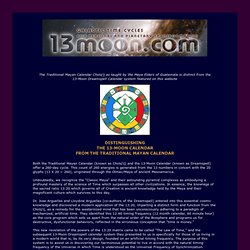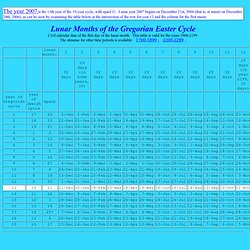

13-Moon Natural Time Calendar : Time Is Art! The Chinese Calendar. Chinese New Year Celebrations Chinese New Year parades have their origins in the California Gold Rush, when immigrants sought to share their culture.

Today, New Year’s parades take place around the globe. Natural Time Update. The Traditional Mayan Calendar Cholq'ij as taught by the Maya Elders of Guatemala is distinct from the 13-Moon Dreamspell Calendar system featured on this website Both the Traditional Mayan Calendar (known as Cholq'ij) and the 13-Moon Calendar (known as Dreamspell) offer a 260-day cycle.

This count of 260 energies is generated from the 13 numbers in concert with the 20 glyphs (13 X 20 = 260), originated through the Olmec/Maya of ancient Mesoamerica. Undoubtedly, we recognize the "Classic Maya" and their astounding pyramid complexes as embodying a profound mastery of the science of Time which surpasses all other civilizations. In essence, the knowlege of the sacred ratio 13:20 which governs all of Creation is ancient knowledge held by the Maya and their magnificent culture which survives to this day.
A 13-month Lunar Calendar with Solar Dates. 1993JHA....24..204M Page 2:204. What is the Celtic Tree Calendar? Copyright 1999 by Linda Kerr The Beth-Luis-Nion Celtic Lunar Tree Calendar/alphabet consists of 13 lunar trees and five solar trees.

The 13 Lunar Months. Jewish Calendar. A few years ago, I was in a synagogue, and I overheard one man ask another, "When is Chanukkah this year?

" The other man smiled slyly and replied, "Same as always: the 25th of Kislev. " This humorous comment makes an important point: the date of Jewish holidays does not change from year to year. Holidays are celebrated on the same day of the Jewish calendar every year, but the Jewish year is not the same length as a solar year on the civil calendar used by most of the western world, so the date shifts on the civil calendar. Background and History. 13 Moons of Peace* Dreamspell Calendar & 2012 Prophecy. Gregorian Lunar Calendar. Lunar Months of the Gregorian Easter CycleCivil calendar date of the first day of the lunar month.

This table is valid for the years 1900-2199.The almanac for other time periods is available: 1700-1899 ; 2200-2299 . How to use this table: The year: The Gregorian lunar almanac (also called the Gregorian "ecclesiastical moon") is a 19-year cycle which assigns an age of the moon to every day in the 19-year period. Year one of the Gregorian cycle is any year in which the year's number is divisible by 19 without remainder. The month: Each year contains 12 or 13 lunar months. Although each lunar month contains formally either 29 or 30 days, in the Gregorian lunar almanac the actual number of days assigned to a given lunation might be as few as 28 (when the almanac assigns lunar ages differing by 2 to successive days in a month formally having 29 days) and as many as 31 (when the almanac assigns the same lunar age to successive days in a month formally having 30 days).
Lunar month. Conversion of Chinese Lunar Calendar - Gregorian Calendar. The Lunar Calendar in "The Invisible Landscape" Most "Goddess Calendars" that you can find on the web are actually just the usual Gregorian Calendar with the twelve months renamed after goddesses, so they are not really new calendars — and they are solar calendars, not lunar calendars.

This page defines an accurate 13-month lunar calendar in which the months actually do coincide with the lunar cycles. It is based on a proposal for a new calendar made by Terence McKenna in 1987 but has been given its final form only recently. Terence McKenna's Goddess Calendar In The Invisible Landscape Terence McKenna cited a scholar who suggested that the I Ching hexagrams were connected with some early calendar system (see the 1975 edition, Chapter 8, pages 113-114).
He then proceeded to speculate that the neolithic Chinese used a lunar calendar in which a year of 384 days consisted of 13 lunar months (alternating in length between 29 days and 30 days). An accurate lunar calendar, however, is not constructed as easily as one might suppose.